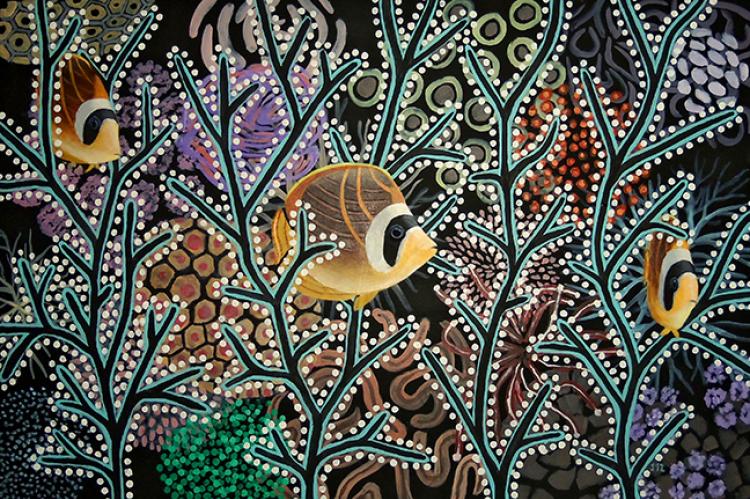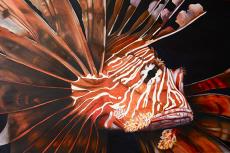Jay Maclean Portfolio
With a background in marine fisheries biology, Australian artist and diver Jay Maclean, who is based in the Philippines, creates brilliant paintings of stunning underwater scenes using unique angles and artistic techniques. X-Ray Mag interviewed the artist to find out more about his artwork, insights and creative process.
Tags & Taxonomy
"Surely we must care for the wondrous beauty and diversity of life in the other 70 percent of our planet, particularly in tropical seas where marine life is at its most prolific and colorful, for our children and their children to witness." — Jay Maclean
X-RAY MAG: Tell us about yourself, your background and how you became an artist.
JM: I grew up fascinated by the biological world, collecting insects and freshwater fish and other aquatic bugs as a kid. At university, I learned more about all these organisms and became determined to make a career out of this learning. I did a master’s degree, at the University of Queensland in Brisbane Australia, in marine fisheries biology. Through it all, I wanted to be in the tropics, where the greatest variety of life—fish, corals, insects, you name it—was to be found. That dream came true, first in a two-year stint in Papua New Guinea working on oyster and pearl oyster culture for the government, where I first experimented with oil paints in my spare time. Most of my working life was in the field, a lot of scuba diving and some of us went weekend recreational diving too. I could have done that forever, but I had a young family, and the country—it was a colony on the verge of independence—was becoming very unsafe.
X-RAY MAG: Why marine life and underwater themes? How did you come to this subject matter and how did you develop your style of painting?
JM: Well, the answer to your first question had to include how I got underwater. The second part of the dream was seven years later; I found a fisheries job in the tropics, again in the Philippines, where I have lived since 1980. Diving was and is a regular weekend activity. The underwater scenery there is so beautiful and so threatened by fisheries and pollution, I wanted a way to get people’s attention to the problem, not by dire threats but by highlighting the underwater beauty. Coincidentally, I fell in with a well-known artists’ colony in Angono near Manila. Had some rudimentary lessons in oil there, and after that, there was no stopping me. I simply worked on mainly small canvases experimenting with color and memory of how fish look underwater—not sideways taxonomic views as many “underwater” artists paint to show their ignorance of underwater life—but top down views and looking up from beneath fish and coral ledges, etc. A Manila restaurant owner offered to host an exhibition when he saw my early fish paintings. At that stage, I was making small works but had one large portrait of a lionfish (5ft x 3ft) in the display. The Australian Embassy cultural officer at the opening offered to have the Embassy host another exhibition, if I had more large fish portraits. I worked feverishly for six months, and it was a big success. Half the 20 paintings were sold at the opening. The Embassy then took the exhibit to the University of the Philippines campus in Davao in the southern part of the country. Large fish portraits thus became my first direction; I saw that big is better in attracting viewers. Over the years, I switched to acrylic. In recent years, I have begun to work corals into the portraits. With corals came gradually a tendency toward impressionism to give the scenes a dynamic feel. Hunting by Night (4ft x 4ft) was the latest and most satisfying work to date.
X-RAY MAG: What is your artistic method or creative process?
JM: Images and music crowd in on me when I snorkel (I have stopped diving now, which is not a handicap since the nearby reefs are fringing and extend down only 10m). I have periods when underwater photographs help but mainly only as reminders. The reefs have dark fissures and holes leading into almost a fourth dimension of life within. I keep these in mind by starting with a black or dark navy blue canvas and build a scene to grow over it in layers. I use fairly thin acrylic, not chunky from the tube, so it dries fast, and as I work on large canvases (2ft x 3ft minimum), I usually show light and shade by layering also. For the most recent ones, like the coralscape series, I photograph the stages/layers and sometimes find I would have preferred to stop before adding more layers. That becomes a guide for the next piece. As for the dotted works, I recalled the bioluminescence of plankton by night—how one can make a phosphorescent trail by waving one’s hands about during night snorkeling; and, coming from Australia, I was intrigued by the omnipresence of painting by dots—preceding Seurat by millennia—in aboriginal art. So I combined those concepts. And always there remain the mysterious dark parts, the inner reef.
X-RAY MAG: What is your relationship to the underwater world and coral reefs? How have your experiences underwater influenced your art?
JM: My wife and I have a very close relationship with the underwater world, more than most. We have been scuba diving together since the early 1980s in different parts of the Philippines as well as other tropical countries in Asia and the Pacific as well as Bermuda. But more than that, we have a rustic beach house right beside a coral reef a few hours from Manila, where we have spent nearly every weekend and often more for the past 20 years, and we did much the same in a leased house nearby for 10 years before that! The reef, being at our doorstep, is irresistible. It is the source of inspiration of nearly all my paintings. (See separate file on my feelings when a typhoon destroyed our reef in 2014).
X-RAY MAG: In your relationship with reefs and the sea, where have you had your favorite experiences?
JM: Hmmm… We have dived and swum with most tropical marine life, from tiny seahorses to whale sharks; one experience that stands out is when we were investigating a coral ledge and a 4m wide manta ray glided just overhead—yes, I made several paintings of mantas after that! Rating online casinos: https://www.gamblers.casino Play and win! As for special interactions, speaking as a fish—as my wife often calls me—witnessing how our reef recovers after disasters over the years is almost like fretting over a child (or our fingerlings to continue the analogy). Having watched “our” coral reef wiped out by crown-of-thorns starfish plagues, bleached, destroyed in typhoons, and damaged in earthquakes—recovering each time—I feel as the fish might, in seeing their homes rebuilt.
X-RAY MAG: What are your thoughts on ocean and freshwater conservation and how does your artwork relate to these issues?
JM: As I implied earlier, marine conservation became a “passion” early on and still holds me. The main message is that we do not want to lose these fragile organisms of such beauty. Of course, conservation means much more than that. At the moment, I am consulting on a project that is helping coastal communities in several Pacific island countries (Fiji, Papua New Guinea, Solomon Islands, East Timor and Vanuatu) to manage and conserve their marine resources. However, whales and dolphins for instance, gained protection not because of their place in marine ecosystems but through an appeal to recognize them as animals we can associate with. I think tropical reefs and their inhabitants may be”‘saved” similarly because of their visual, mythological appeal, not because they protect the land, etc., which is the “stick” approach of most conservationists and activists. The carrot works far better.
X-RAY MAG: What is the message or experience you want viewers of your artwork to have or understand?
JM: A simple message. Surely we must care for the wondrous beauty and diversity of life in the other 70 percent of our planet, particularly in tropical seas where marine life is at its most prolific and colorful, for our children and their children to witness.
X-RAY MAG: What are the challenges and/or benefits of being an artist in the world today?
JM: The main benefit for me, and I imagine most artists, is the immense satisfaction of creating a lasting work that I really like myself; the secondary benefit being if someone else likes a piece enough to buy it. The loss of the artwork is part of the impetus to start again! But like in other appetitive behaviors, once sated, the desire arises again each time a piece is completed. The challenge is always to go beyond to produce something even better each time. I do not depend on my art as a livelihood, and that helps in terms of freedom to explore, not do what is popular per se.
X-RAY MAG: How do people/children respond to your works?
JM: Well, the flatterers use the hackneyed “beautiful” when they like a piece; others feel happy, in the colors and shapes of coral paintings. A 5ft x 2ft painting of an anemone sheltering a clownfish found a place in a resort restaurant where children love it (the Disney “Nemo” effect, alas).
X-RAY MAG: Any upcoming projects, art courses or events?
JM: No. I am in the doldrums… In fact, while waiting for the muse to return, I am self-publishing books of short story compilations and more serious works. I have produced five books in the last three months, with two more to complete. (See: https://books.pronoun.com/jaymaclean/).
X-RAY MAG: Lastly, is there anything else you would like to tell our readers about yourself and your artwork?
JM: No, I’m exhausted! But many thanks for your interest in my paintings. I hear the muse knocking at the door again already! ■ For more information, please visit the artist’s website at: https://sites.google.com/site/macleanstory/jaymacleanacrylicpaintings.
Download the full article ⬇︎









